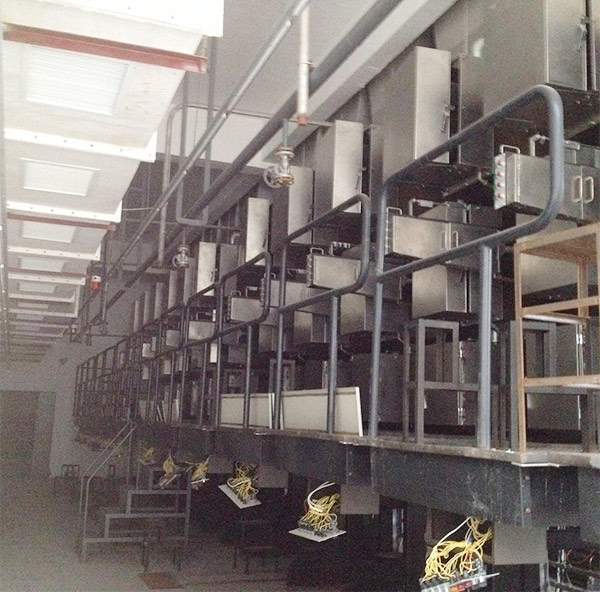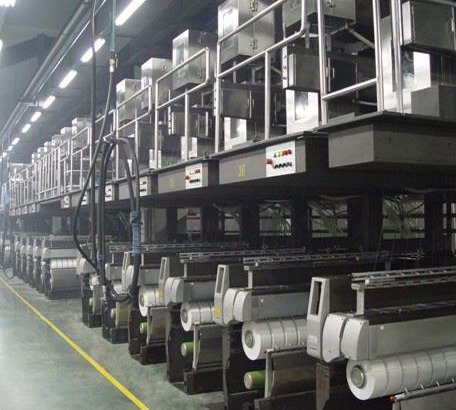- Polypropylene spinning machine
- Polypropylene FDY equipment
- Polyester POY spinning machine
- Polyamide FDY common and high strength equipment
- Polyester FDY equipment
- Polyester high strength equipment
- polyester、Polyamide、 Polypropylene BCF equipment
- Small spinning machine
- All kinds of spinning special parts
- Management Skills: Managing Problems = Managing Efficiency: Anchor the essence of management, Break through problems and seek results through efficiency!
- Shandong is promoting the transformation and upgrading of its textile industry through intelligent manufacturing
- Guide to Parameters of Polypropylene Spinning Machine Equipment
- The second Smart Fiber and Flexible Wearable Technology Exchange Conference was held in Nantong, Jiangsu Province
- Minor Snow moistens the cold, craftsmanship weaves warmth: An Analysis of the Core Temperature of Polypropylene Spinning Machines

- Contact:Mr. Huang Guofu
- Cel:0086-13901505556
- Fax:0086-519-83341119
- Email:czfb5556@126.com
- Add:No. 288-8 ChangLi Rd, Huangli Town, Changzhou, JS PRV.
In enterprise management, promoting employees to leadership positions is a major matter concerning the development of the team and the future of the enterprise. However, some employees may seem to perform well, but once they take on leadership positions, what they bring may not be positive motivation but numerous problems. If the following six types of employees are promoted to leadership positions, it is very likely to be a threat and hidden danger to the team and the enterprise. Managers must be highly vigilant.
When six types of employees are appointed as leaders, caution should be exercised when promoting them
1. Employees who are top in business but don't know how to lead a team
Such employees have outstanding business capabilities and top performance, and they are the business benchmarks of the team. However, leadership positions require even more the ability to lead a team, such as task allocation, relationship coordination, and potential stimulation. If they are pushed to a leadership position, due to their lack of management skills, it is easy for team members to act independently. Moreover, they may overly focus on individual performance and neglect the overall team goals. If this continues for a long time, the team's cohesion and combat effectiveness will decline significantly.
2. Employees who only work hard but lack strategic thinking
Such employees are diligent and down-to-earth at work and perform outstandingly in carrying out specific tasks. However, leaders need to have strategic thinking, be able to plan for the long term and grasp the direction from a high vantage point. Such employees often only focus on the immediate work and lack the ability to predict and plan. After becoming a leader, one may lead the team into blind busyness, fail to keep up with the development of the enterprise and miss opportunities.
3. Employees with low emotional intelligence and poor communication and coordination skills
Leaders need to frequently communicate and coordinate with team members, other departments and external partners. Employees with low emotional intelligence are not good at putting themselves in others' shoes and speak without considering others' feelings, which can easily lead to conflicts and disputes. Such leaders find it hard to build good interpersonal relationships, fail to gain the trust and support of the team, and are unable to collaborate effectively with other departments, which seriously affects team efficiency and business operations.
4. Employees who lack a sense of responsibility and shirk responsibility when encountering problems
Leaders are responsible for the work achievements and development of the team. Employees who lack a sense of responsibility and shirk their duties in daily life will find it difficult to take on heavy responsibilities even when they become leaders. When a team is in trouble, they may first consider their own interests and shift the blame onto others or other factors, making the problem difficult to solve and greatly undermining the team's morale.
5. Employees who are jealous of their talents and ability and suppress their subordinates
Such employees have certain capabilities but are narrow-minded and cannot stand to see their subordinates excel. After becoming a leader, one tends to suppress and exclude capable subordinates, fearing that they might surpass oneself. This will cause outstanding talents in the team to leave without being given important positions, leading to a decline in the overall quality of the team and constraints on innovation capabilities, which is extremely detrimental to the long-term development of the enterprise.
6. Employees who do not follow the rules and have a weak sense of discipline
Leaders should abide by the enterprise's rules and regulations and set a good example for team members. Employees who themselves do not follow the rules, have poor discipline awareness and often break the rules, when they become leaders, not only fail to restrain team members, but may also spoil the team atmosphere, leading to lax discipline and disorder, which seriously affects the normal operation and management of the enterprise.
Ii. The Cost of Abusing Small Power: The Transformation from a supervisor to a "corporate Parasite"
In enterprises, there are always some people who, once they grasp a little power, immediately become carried away and lose themselves. Even a minor supervisor can't wait to put on an air of authority - he is always harsh and stern at his subordinates, scolding them loudly at the slightest dissatisfaction, and even using fines as a tool to show off his authority, completely disregarding the word "respect", and treating his subordinates as objects of exploitation that can be manipulated at will. Such people, in the face of the temptation of power, are often like wild horses that have broken free from their REINS and are very likely to fall into the abyss of making mistakes. Their inappropriate behaviors are mainly reflected in the following aspects:
Abusing power for personal gain
They have distorted the management rights granted by the company into a powerful tool for personal gain, and are willing to sacrifice the company's interests and colleagues' rights and interests to line their own pockets. Forming cliques and eliminating dissidents within the team, deliberately creating conflicts and disputes, only caring about one's own small plot of land, completely disregarding the growth and development of subordinates, let alone the long-term planning of the company.
Abusing power and acting recklessly
Once in power, they quickly inflate themselves and overstep their bounds in the maelstrom of power: deceiving and covering up their superiors, domineering and suppressing their subordinates, and even overstepping their bounds and interfering in areas beyond their authority. They attempt to satisfy their ever-expanding ambitions and greed by abusing their power, eroding the company's management order like worms and sowing huge hidden dangers for the stable development of the enterprise.
Hegemonic autocracy
After taking the position of supervisor, he was busy building his own "independent kingdom" : he suppressed talented subordinates in every possible way, firmly held onto power and refused to delegate it, turning the team into a complete one-man show. When making decisions, one acts arbitrarily and places personal interests above those of the company. The higher the position of such people, the more fatal the harm they cause to the enterprise, just like a time bomb hidden in the organization, which may trigger a systemic crisis at any time.
Iii. Key Strategies for Building a Cohesive Team
In a highly competitive business environment, a cohesive team is at the core of an organization's success To build such a team, efforts should be made from multiple dimensions.
Consensus goals, the foundation of cohesion. Common goals are the source of cohesion. Leaders should transform the organizational vision into specific team goals, making members clear about the connection between their own work and the team's goals. Goal setting should incorporate the opinions of members and form a consensus. Break down major goals into phased tasks, conduct regular reviews, and enhance cohesion through achievements.
Open communication, breaking down barriers. Smooth communication is the bridge that unites the team. The team needs to establish a multi-level communication mechanism, including daily instant communication, regular in-depth exchanges and informal communication. Leaders should foster an open atmosphere, encourage the expression of diverse viewpoints, and guide rational resolution of conflicts, thereby enhancing trust and fostering a collaborative rapport.
Empower growth and inspire motivation. An outstanding team is a platform for its members to grow together. The organization should provide training resources and promotion channels, and grant members autonomy. Leaders should pay attention to the strengths of their members and arrange positions reasonably. When members feel the organization's emphasis on their development, they will be more willing to contribute to the team.
Shaping culture and consolidating the core team culture serves as the spiritual bond of cohesion, which is reflected in the details of daily work. Distill common values and put them into practice, allowing culture to permeate all aspects of team operation and enhance team cohesion.
In conclusion, when promoting leaders, enterprises must comprehensively assess the overall quality of employees and should not only focus on the performance of a certain aspect. If the above six types of employees are accidentally promoted to leadership positions, measures should be taken promptly to make adjustments once problems are identified. Their capabilities can be enhanced through training. If they are truly unable to handle the job, they should be replaced without hesitation to avoid causing greater losses to the team and the enterprise. Only by selecting truly suitable leaders can the team be led to continuous development and the enterprise be driven towards a better future.
The content and template of this article are compiled from the Internet. The copyright belongs to the original author. If there is any infringement, please inform us in time and contact us for deletion.
Changzhou Fubon Chemical Fiber Machinery Factory Technical production: Polypropylene spinning machine, polypropylene FDY spinning machine, polypropylene FDY equipment, polyester POY spinning machine, polyester POY production line, polyester POY equipment, polyester POY machinery, polyester recycled bottle FDY spinning machine, polyester FDY spinning machine, polyester FDY machinery, Spandex spinning machine, spinning special parts, polyester small Experimental machine, polypropylene small experimental machine, nylon small experimental machine.
Changzhou Fubon Chemical Fiber Machinery Factory Technical is a research and development and production of all kinds of chemical fiber machinery as the main professional manufacturing suppliers, research, development, production and sales as one, in order to meet the market demand, our factory has established a perfect chemical fiber spinning experimental base, to provide customers with good equipment and technical services. We mainly provide customers with complete sets of polyester, polypropylene, nylon, spandex and other chemical fiber complete sets of equipment, and undertake a variety of related equipment renovation projects and customized services.
- Management Skills: Managing Problems = Managing Efficiency: Anchor the essence of manageme
- Shandong is promoting the transformation and upgrading of its textile industry through int
- Guide to Parameters of Polypropylene Spinning Machine Equipment
- The second Smart Fiber and Flexible Wearable Technology Exchange Conference was held in Na
- Minor Snow moistens the cold, craftsmanship weaves warmth: An Analysis of the Core Tempera
- Textile News: Takeout windbreakers are popular both at home and Abroad, and AI design brea
- The 6th Liaoning Province Textile and Materials Graduate Forum and Textile Young Scholars
- During the cool weather, polypropylene FDY spinning machines facilitate efficient producti
- The Start of Winter has arrived. May you have a safe winter! Fubang Chemical Fiber Machine
- The National Alliance of Model Workers and Skilled Craftsmen Innovation Studios in the Tex




